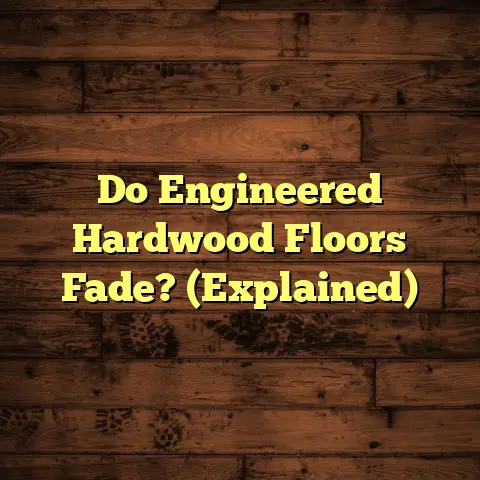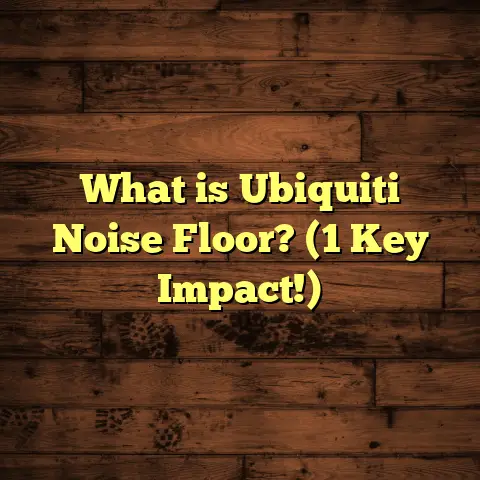DIY Floor Sander Buying Guide (Don’t Get Ripped!)
Don’t Get Ripped Off (And Keep Your Ears!)
I’m your friendly neighborhood flooring contractor, and today we’re diving deep into the world of floor sanders.If you’re anything like me, you love the satisfaction of tackling a home renovation project. But let’s be honest, some tools can be a real pain – literally, to your ears!
Floor sanders, while essential for bringing your old floors back to life, can be incredibly noisy.
I can’t tell you how many times I’ve finished a sanding job with my ears ringing like crazy.
That’s why I’m here to guide you through the process of choosing a floor sander that won’t just get the job done, but will also keep your sanity (and your neighbor’s!) intact.
We’ll explore the different types of sanders, key features to look for, and how to find the perfect balance between power, performance, and noise reduction.
Let’s get started!
Introduction: Noise Reduction in Floor Sanding
Why is noise reduction so important when it comes to floor sanding?
Well, imagine spending hours wrestling with a machine that sounds like a jet engine taking off in your living room. Not exactly a relaxing experience, right?
Traditional floor sanders can produce a deafening roar, making it difficult to concentrate, communicate, or even enjoy your favorite playlist while you work.
Beyond the immediate annoyance, prolonged exposure to loud noise can have serious health consequences.
Think stress, fatigue, and even permanent hearing damage.
Trust me, I’ve seen it happen to colleagues who didn’t take proper precautions.
And let’s not forget about your neighbors! Nobody wants to be the person who subjects their entire street to hours of ear-splitting noise.
Keeping the peace is essential, especially if you live in a densely populated area.
Statistics and Facts
Did you know that some floor sanders can produce noise levels exceeding 100 decibels (dB)?
That’s louder than a chainsaw or a motorcycle! According to the National Institute for Occupational Safety and Health (NIOSH), prolonged exposure to noise levels above 85 dB can lead to hearing loss.
To put that in perspective, here’s a quick table comparing noise levels of common floor sanders:
| Sander Type | Typical Noise Level (dB) |
|---|---|
| Drum Sander | 95-105 |
| Belt Sander | 90-100 |
| Orbital Sander | 75-90 |
As you can see, some sanders are significantly louder than others.
Health Implications
Prolonged exposure to high noise levels can lead to a range of health problems, including:
- Hearing Loss: This is the most obvious risk. Constant loud noise damages the delicate hair cells in your inner ear, leading to gradual or sudden hearing impairment.
- Tinnitus: That persistent ringing or buzzing in your ears? That’s tinnitus, and it’s often caused by noise exposure. It can be incredibly distracting and affect your quality of life.
- Stress and Anxiety: Loud noise triggers the body’s stress response, leading to increased heart rate, blood pressure, and anxiety.
- Sleep Disturbances: Noise can disrupt your sleep patterns, leading to fatigue, irritability, and decreased cognitive function.
Protecting your hearing is crucial, and choosing a quieter floor sander is a great first step.
Section 1: Understanding Different Types of Floor Sanders
Alright, let’s talk about the different types of floor sanders you’ll encounter. Each type has its own strengths and weaknesses, including noise output.
Belt Sanders
Belt sanders are aggressive and powerful, making them ideal for removing heavy coatings or leveling uneven surfaces.
They use a continuous loop of sandpaper that rotates at high speed, quickly grinding away material.
Pros:
- Efficient for removing old finishes and leveling floors.
- Can cover large areas quickly.
Cons:
- Very noisy, typically producing 90-100 dB.
- Can be difficult to control, potentially leading to gouges or uneven sanding.
- Not ideal for detail work or delicate surfaces.
In my experience, belt sanders are best left to professionals or experienced DIYers who need to tackle tough jobs.
The noise alone is enough to make you want to wear earplugs and a noise-canceling headset!
Orbital Sanders
Orbital sanders, also known as random orbital sanders, use a circular sanding pad that moves in an elliptical motion.
This random movement helps to prevent swirl marks and provides a smoother, more even finish.
Pros:
- Quieter than belt sanders, typically producing 75-90 dB.
- Easier to control and less likely to cause damage.
- Versatile and suitable for a wide range of sanding tasks.
- Great for detail work and sanding edges.
Cons:
- Slower than belt sanders for removing heavy coatings.
- May require multiple passes to achieve the desired results.
For most DIY projects in residential areas, I highly recommend using an orbital sander.
They’re quieter, more forgiving, and produce excellent results with a bit of patience.
Drum Sanders
Drum sanders are large, powerful machines designed for sanding large areas quickly.
They use a rotating drum covered in sandpaper to aggressively remove material.
Pros:
- Extremely efficient for sanding large areas.
- Can remove heavy coatings and level floors quickly.
Cons:
- Extremely noisy, typically producing 95-105 dB.
- Difficult to control and can easily damage floors.
- Expensive to rent or purchase.
- Not suitable for small spaces or detail work.
In my opinion, drum sanders are overkill for most DIY projects.
The noise level is unbearable, and the risk of damaging your floors is high. Unless you’re a seasoned professional, I’d steer clear of these beasts.
Section 2: Key Features to Look for When Buying a Floor Sander
Now that you know the different types of sanders, let’s talk about the key features to consider when making your purchase.
Noise Reduction Technology
Some floor sanders incorporate specific noise-reduction technologies to minimize sound output.
These features can include:
- Sound Insulation: Using materials like foam or rubber to dampen vibrations and reduce noise transmission.
- Quieter Motors: Employing motors with optimized designs and components to minimize noise generation.
- Design Enhancements: Incorporating features like enclosed housings and vibration-dampening mounts to reduce noise.
Look for sanders that specifically advertise noise-reduction features.
Read customer reviews to see if users report a noticeable difference in noise levels compared to traditional models.
Power and Efficiency
The power of a floor sander is typically measured in amps or wattage.
A more powerful sander will generally remove material faster, but it may also produce more noise.
It’s a trade-off you need to consider.
- Higher Power: Faster sanding, but potentially louder.
- Lower Power: Quieter operation, but may require more time and effort.
Consider the type of sanding you’ll be doing most often.
If you’re primarily working on light to medium sanding tasks, a lower-power, quieter sander may be the best choice.
If you need to remove heavy coatings or level uneven surfaces, you may need to opt for a more powerful model, but be prepared for the increased noise.
Weight and Portability
The weight of a floor sander can significantly affect its ease of use and maneuverability.
A heavier sander may be more stable and easier to control, but it can also be more tiring to operate for extended periods.
A lighter sander may be easier to move around, but it may also vibrate more and produce more noise.
Consider your physical strength and the size of the area you’ll be sanding.
If you have a large area to cover, a self-propelled sander might be a good investment, even if it’s a bit heavier.
Section 3: Evaluating Brands and Models
Choosing the right brand and model can make all the difference in your sanding experience.
Brand Reputation
Some brands have a reputation for producing high-quality, durable, and quieter floor sanders.
Here are a few brands to consider:
- Festool: Known for their high-end, dust-extraction-equipped sanders that are designed for quieter operation.
- Bosch: Offers a range of sanders with good performance and reasonable noise levels.
- DeWalt: Produces durable and powerful sanders, but noise levels can vary depending on the model.
- Makita: Offers a variety of sanders with a good balance of power, performance, and noise reduction.
Always read customer reviews before making a purchase. Pay close attention to comments about noise levels, durability, and overall performance.
Model Comparisons
Here’s a comparison chart of popular floor sander models, highlighting their noise ratings, efficiency, and user feedback regarding sound levels:
| Model | Type | Noise Level (dB) | Efficiency | User Feedback (Noise) |
|---|---|---|---|---|
| Festool Rotex RO 150 FEQ | Random Orbital | 71 | High | “Surprisingly quiet for a sander of this power.” |
| Bosch GET75-6N | Random Orbital | 78 | Medium | “Noticeably quieter than my old sander.” |
| DeWalt DWE6423 | Random Orbital | 84 | Medium | “A bit loud, but not unbearable.” |
| Makita BO5041K | Random Orbital | 77 | Medium | “Very comfortable to use, and the noise level is acceptable.” |
Keep in mind that these are approximate noise levels, and actual noise output may vary depending on the sanding surface and operating conditions.
Section 4: Budgeting for Your Purchase
Floor sanders can range in price from a few hundred dollars to several thousand dollars.
It’s important to set a budget before you start shopping and to consider the long-term costs of owning a sander.
Price Ranges
- Entry-Level Sanders: $100 – $300. These are typically smaller, less powerful sanders that may not be ideal for heavy-duty sanding. They may also be noisier than more expensive models.
- Mid-Range Sanders: $300 – $800. These sanders offer a good balance of power, performance, and features. They may include noise-reduction technology and are suitable for a wide range of sanding tasks.
- High-End Sanders: $800+. These are professional-grade sanders that offer exceptional performance, durability, and noise reduction. They are typically used by contractors and experienced DIYers.
Remember that cheaper models may not only lack efficiency but also tend to be noisier.
Long-Term Investment
Investing in a quality, quieter sander can save you money in the long run.
Here’s why:
- Reduced Need for Hearing Protection: A quieter sander means you won’t have to rely as heavily on earplugs or noise-canceling headphones.
- Fewer Disturbances for Neighbors: Avoiding noise complaints can save you from potential fines or legal issues.
- Improved Working Conditions: A quieter work environment can reduce stress and fatigue, leading to increased productivity.
- Durability: Higher-quality sanders tend to last longer, saving you money on repairs and replacements.
Section 5: Where to Purchase
You have several options when it comes to purchasing a floor sander.
Retail vs. Online
- Retail Stores: Offer the advantage of being able to see and handle the sander before you buy it. You can also ask questions and get advice from sales staff.
- Online Platforms: Offer a wider selection of models and often have lower prices. You can also read customer reviews and compare prices easily.
I recommend visiting a retail store to get a feel for different sanders, then comparing prices and reviews online before making your final decision.
Rental Options
If you only need to sand floors occasionally, renting a high-quality, quieter sander may be a cost-effective solution.
Many tool rental companies offer a variety of floor sanders for rent, including orbital sanders and even some models with noise-reduction features.
Renting allows you to use a professional-grade sander without having to invest in a costly purchase.
It’s also a great way to try out different models before deciding which one to buy.
Section 6: Additional Considerations
Before you start sanding, there are a few additional considerations to keep in mind.
Noise Protection Gear
Even with a quieter sander, it’s essential to wear appropriate personal protective equipment (PPE).
This includes:
- Earplugs: Foam earplugs are an inexpensive and effective way to reduce noise exposure.
- Noise-Canceling Headphones: Offer superior noise reduction and can also be used to listen to music or podcasts while you work.
- Safety Glasses: Protect your eyes from dust and debris.
- Dust Mask: Prevent you from inhaling harmful dust particles.
Community Guidelines
Be aware of local noise ordinances and community guidelines that may affect when and where you can use a floor sander.
Many communities have restrictions on noise levels and operating hours, especially in residential areas.
Check with your local authorities or homeowner’s association to ensure you’re in compliance with all applicable regulations.
Conclusion: Making an Informed Decision
Choosing the right floor sander is an important decision that can affect the quality of your work, your health, and your relationships with your neighbors.
By considering noise levels along with other key features like power, efficiency, and weight, you can find a sander that meets your needs without subjecting yourself to excessive noise.
Remember to do your research, read reviews, and consider your specific needs before making a purchase.
A thoughtful choice will not only improve your sanding experience but also protect you and your community from excessive noise disturbances.
So, go forth and sand with confidence (and a little less noise)!





